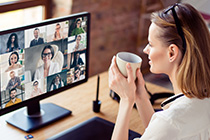While virtual conference calls and online meetings were already available to businesses, the events of the last 12 months have seen platforms like Microsoft Teams become defacto meeting platforms.
The onset of remote working means that your people are now accustomed to logging in to multiple calls a day, and these new practices are unlikely to go away any time soon.
Towards the end of last year, Microsoft highlighted this sea change by revealing that its usage had grown by 50%, up to 115 million daily active users from 75 million 6 months previous. Recent estimates suggest that this has grown even further, with a figure of around 145 million muted.
However, while these platforms have cemented a place in your business kit bag, a return to near normality is coming into view. As we discussed in our previous blog, hybrid working will be the order of the day. As such, understanding how you can continue to take advantage of new working practices while properly accommodating both remote and office-based users is a growing consideration.
The meeting room of the future
In the modern, hybrid workplace, gathering multiple participants in a single room is unlikely to be as easy, or accepted as it was pre-pandemic. For starters, it’s likely that the number of physical meeting room attendees might need to be reduced, with social distancing measures introduced for safety.
Additionally, some participants might still be required to work and attend from remote locations due to phased return to work plans, while travel restrictions might prevent those from further afield even being able to make it to your office.
This presents multiple challenges. Dialling in on a traditional conference phone allows everyone to participate, but doesn’t make for an immersive experience. Nor would connecting with remote participants via a single laptop.
For the best meeting experience, you want every participant to feel like they are in the room, even if they are not. This means implementing video conferencing software, such as Microsoft Teams, and combining this with appropriate audio and visual hardware so that every participant can be seen and heard.
Teams Rooms – the right tool for the job
Alongside its Teams desktop and mobile client Microsoft has also created a native Teams app, available with a number of devices supplied by leading partners such as Poly, Yealink, and Logitech, as part of an integrated Teams Rooms solution that allows you to bring virtual meetings back to the office.
At its core, Teams Rooms is designed to create a more inclusive, engaging, and reliable experience for both remote and office-based participants. A simple joining experience, combined with flexible in-meeting options sees that you can stay connected and enjoy productive meetings without compromise.
Here are some of the standout features:
1. One-touch and proximity join
As part of a return to the office, ensuring appropriate use of communal spaces is one of the biggest priorities for business leaders. While policies can be implemented to enforce the wiping down of multi-use equipment, avoiding regular physical interaction with communal devices is still the best approach.
With one-touch join, your users can join an existing meeting via their Teams control panel with a single click, automatically connecting them to accessible devices in that room without the need to plug in or click through multiple steps. Going one step further, proximity join allows you to connect to Teams Rooms technology from your existing devices, avoiding the need to interact with communal hardware at all. Your laptop or mobile will automatically recognise that you are in an appropriate Teams Room, and will give you the option to share your meeting with connected devices.
Should additional physical participants also join the meeting from their own devices, their audio and visual output is automatically muted to avoid unwanted feedback or disruption.
2. Taking centre stage
In a busy meeting it can always be difficult to make yourself heard when raising an important point. However, the leader of your Teams Rooms meeting can easily identify a single remote contributor and make them the focus, highlighting their visual output for all other participants as the main presenter shown on screen.
You can also use Microsoft’s whiteboard app to capture thoughts and ideas for all participants, while intelligent content cameras can be installed to track physical whiteboards and other similar equipment. These cameras will automatically zoom in to a physical whiteboard, and share the visual with remote participants as if this was being shared by another attendee.
3. Meeting room management
Away from the in-meeting experience, managing the use of physical spaces for those in the office will also have an important role to play in any return to work.
As announced during Microsoft Ignite, a new Teams panels feature is set for imminent release, and will help in-office participants to make better use of your meeting room spaces. Built in conjunction with Creston and Yealink, Teams panels devices will alert attendees when a meeting room is over capacity. It will also make you aware of the availability of nearby rooms should you need to extend into an additional space. Those waiting to use the room can also send check-in notifications to alert current users that they are waiting.
It’s safe to say that meetings will never be the same again, and with technology like Microsoft Teams Rooms it’s easy to create a modern, accessible, and inclusive meeting experience that caters for every member of your team.
To learn more about Microsoft Teams, Teams Rooms, and how you can prepare for hybrid working with a better, more connected meeting room experience, speak with a member of the team.

